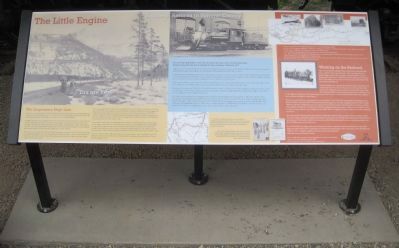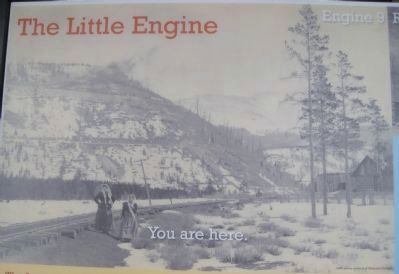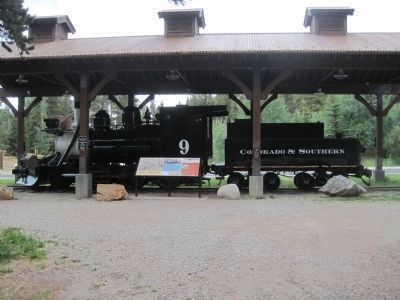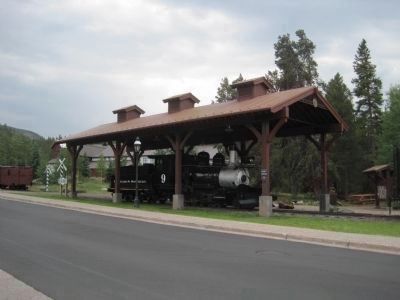Breckenridge in Summit County, Colorado — The American Mountains (Southwest)
The Little Engine / Engine 9 Returns to Summit County
The Legendary High Line / Working on the Railroad
Inscription.
The Little Engine
The Denver, South Park & Pacific (DSP&P) established a crucial link between Denver and the high Rockies. The goal was to reach the Pacific Ocean but the harsh winters and challenging mountain terrain took a toll on the railroad companies. The DSP&P never made it to Utah let alone the Pacific.
By 1880, Como had become a high alpine hub for the railroad. The Continental Divide rose just to the west. In 1882, workers began laying track over Boreas Pass, the highest railroad pass in the nation at that time, reaching 11,493 feet at the summit. Rail service to Breckenridge and Dillon began in 1882. The High Line eventually crossed the Continental Divide again and by 1884 continued on to Leadville. A journey that had taken days by stagecoach or mule train now could be done in about 12 hours.
The High Line transformed life in Summit County. It brought everything from mail, fresh seafood, clothing, coal, and building supplies to livestock, china, pianos, and mining equipment. Outbound trains hauled ore, cattle, sheep, and lumber to Denver. Summit County boomed because of the High Line. It was no longer isolated from the outside world.
On a narrow gauge line like DSP&P, three feet separated the rails rather than the standard four feet, eight and one-half inches. Narrow gauge track could be laid more quickly and cheaply than standard gauge and could better negotiate sharp mountain curves. Steep hills and slow speeds earned the DSP&PRR the nickname “Dam Slow Pullin’ & Pretty Rough Riding.” Facing bankruptcy, the DSP&P reorganized as the Denver, Leadville & Gunnison in 1889. It was then bought the Colorado & Southern (C&S) Railway, which operated the line until it closed in 1937.
Train schedules required precise timekeeping. Station clocks were set by the 11:00 a.m. telegraph signal, so that engineers and conductors could check their watches for accuracy. Railroad families and staff did the same. Other people sometimes set their daily schedule by the train whistles. In the 1930s, Dillon residents listened anxiously for the whistle of the Friday train that brought ice cream for Riley’s grocery store. An eager line formed quickly; disappointed latecomers had to wait another week for their ice cream.
The sever winter of 1898 – 1899 stopped the trains when snow piled to depths that halted travel on the High Line. The train whistles fell silent for 78 days, and the only supplies that reached Summit County arrived via sleighs and skis.
Your are standing within a few feet of where the rails came into Breckenridge.
Engine 9 passed this way hundreds of times
between 1884 and 1937.
Engine 9 is a rare example of a late 19th century steam engine. The Cooke Locomotive and Machine Works of Paterson, New Jersey, built eight identical engines, including No. 9, for the Denver, South Park and Pacific (DSP&P) in 1884.
Coal burning in No. 9’s firebox created steam. The engineer’s throttle sent the steam to the cylinders, where it pushed pistons connected to the driving wheels by rods. Smoke and steam exhausted through the smokestack. Sand dropped from the sand dome, behind the stack, onto the rails near the drivers to prevent slipping. The steam dome contains the throttle.
Steam engines pulled a tender that carried coal and water. As many as four water tanks stood between Como and Breckenridge to refill the tenders. The restored Bakers Tank stands on Boreas Pass Road, about seven miles from Breckenridge.
No. 9 looks like it did in the 1930s. The Colorado &Southern (C&S) installed the “Bear Trap” or Ridgway Smokestack in 1917 or 1918 to catch sparks and hot cinders and prevent fires along the tracks. Its electric headlight replaced the original oil headlight around 1930. No. 9 including the tender weighs about 62 tons.
The C&S used No. 9 primarily in passenger service. It pulled the last passenger train from Leadville to Denver on April 10, 1937. That
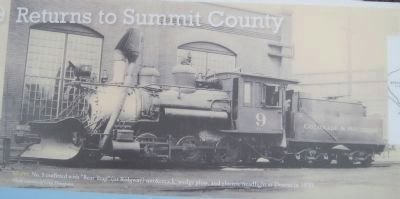
Photographed By Kevin W., July 4, 2012
3. Photo of Engine No. 9 from the The Little Engine / Engine 9 Returns to Summit County Marker
No. 9 outfitted with "Bear Trap" (or Ridgway) smokestack, wedge plow, and electric headlight at Denver in 1930. The photo was provided for use on the marker courtesy of Greg Thompson.
Working on the Railroad
“They weren’t Hollywood John Wayne heroes that worked the High Line,” recalled a relative of the railroader. “They were good, honest, hardworking, gentle, ordinary people of integrity whose word was their bond and who knew what had to be done and just went out and did it.” The High Line demanded a lot from a man and his family; life and work proved difficult.
A fireman helped each engineer. He shoveled coal into the firebox and watched the boiler’s water level. The conductor directed the train’s movements, telling the engineer where to stop and what cars to drop off or pick up. Brakeman set the brakes by precariously walking on top of the slippery, swaying cars. They used a long wooden “club” tool to turn the wheel and set the brakes. Later, engineers used automatic air brakes to control speed.
When
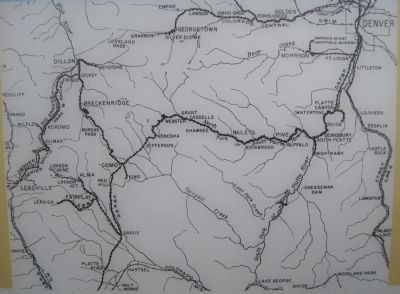
Photographed By Kevin W., July 4, 2012
4. Map of the High Line route on The Little Engine / Engine 9 Returns to Summit County Marker
The Denver, South Park and Pacific route from Denver to Leadville. Passengers boarded the High Line trains at Como, crossed Boreas Pass, descended to Dickey, and crossed Fremont Pass, before arriving in Leadville. Map drawn by E. J. Hailey, courtesy of the Rocky Mountain Railroad Club.
Most days passed with normal hustle and bustle of daily life and the frequent sounds of trains coming down the mountain. Engineers liked to modify their whistles to make distinctive sounds. Railroading families listened for the special sound of the train on which their loved one worked. When they heard it, wives started preparing the next meal. Children ran to wave at the train.
It was a hard but rewarding way to make a living. At the time, carpenters earned around $40 per month, while engineers made $160 or more. Railroaders were often esteemed members of the community. When the High Line closed in 1937, it marked a significant end to an era of true, dedicated railroad pioneers in Summit County.
Erected by
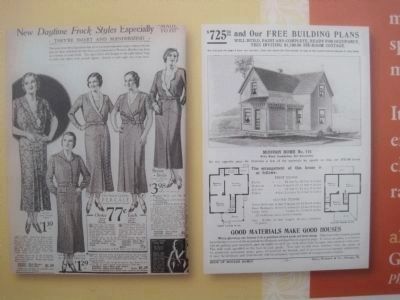
Photographed By Kevin W., July 4, 2012
5. Pictures of Sears Roebuck Catalog items on the Marker
Sears Roebuck Catalogues (left 1930s, right 1908). Trains brought catalogues offering everthing from clothing to toys to farming equipment needed by Summit County families. One could even order several styles of pre-fabricated homes. Images courtesy of Sears Roebuck.
Topics. This historical marker is listed in these topic lists: Railroads & Streetcars • Settlements & Settlers. A significant historical month for this entry is April 2009.
Location. 39° 28.444′ N, 106° 2.43′ W. Marker is in Breckenridge, Colorado, in Summit County. Marker is on Boreas Pass Road (County Road 10) near South Main Street (State Highway 9). Marker is in Rotary Snowplow Park. Touch for map. Marker is in this post office area: Breckenridge CO 80424, United States of America. Touch for directions.
Other nearby markers. At least 8 other markers are within walking distance of this marker. Frozen Over and Snowed Under (within shouting distance of this marker); Breckenridge, Colorado (approx. 0.3 miles away); Soldiers of the Summit (approx. half a mile away); Site of Argyle Dance Hall (approx. half a mile away); The Hearthstone (approx. half a mile away); Barney L. Ford (approx. half a mile away); St. Mary's Church (approx. half a mile away); Riverwalk - Blue River Restoration (approx. 0.6 miles away). Touch for a list and map of all markers in Breckenridge.
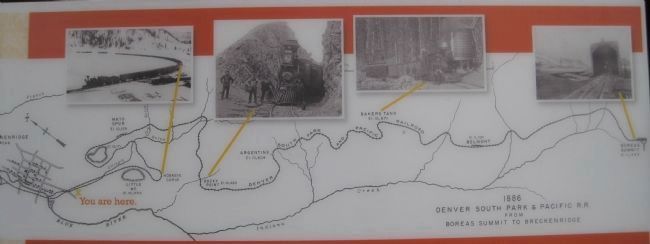
Photographed By Kevin W., July 4, 2012
6. Local area map of the High Line Route with historical photographs.
Left: C&S No. 63 rounding "Hookey Curve" east of Breckenridge in 1900.
Middle left: The engineer, brakeman, and fireman standing next to Denver, Leadville & Gunnison No. 205 at Rocky Point in 1895.
Middle Right: DSP&P No. 10 taking water at the original Baker's Tank.
Right: Looking south through one of the snowsheds covering the tracks at Boreas Pass.
Map: Denver, South Park and Pacific route from Boreas Pass on Breckenridge. From Boreas Pass to Breckenridge, a distance of six and one-half miles, men laid slightly over 11 miles of track.
Photos courtesy of the Salida Museum (left), Dr. Clinton H Scott, Ed and Nancy Bathke collection (middle left), Bill Eloe collection (middle right), and Maureen Nicholls (right).
Map drawn by E. J. Haley, courtesy of the Rocky Mountain Railroad Club.
Middle left: The engineer, brakeman, and fireman standing next to Denver, Leadville & Gunnison No. 205 at Rocky Point in 1895.
Middle Right: DSP&P No. 10 taking water at the original Baker's Tank.
Right: Looking south through one of the snowsheds covering the tracks at Boreas Pass.
Map: Denver, South Park and Pacific route from Boreas Pass on Breckenridge. From Boreas Pass to Breckenridge, a distance of six and one-half miles, men laid slightly over 11 miles of track.
Photos courtesy of the Salida Museum (left), Dr. Clinton H Scott, Ed and Nancy Bathke collection (middle left), Bill Eloe collection (middle right), and Maureen Nicholls (right).
Map drawn by E. J. Haley, courtesy of the Rocky Mountain Railroad Club.
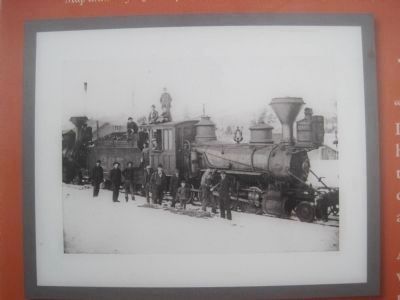
Photographed By Kevin W., July 4, 2012
7. The Little Engine / Engine 9 Returns to Summit County Marker
Railroaders posing for the photographer next to Denver, Leadville & Gunnison No. 265 in Breckenridge in 1897. Photo provided for use on the marker courtesy of the Dr. Clinton H. Scott, Edward and Nancy Rather collections.
Credits. This page was last revised on June 16, 2016. It was originally submitted on January 3, 2013, by Kevin W. of Stafford, Virginia. This page has been viewed 934 times since then and 30 times this year. Photos: 1, 2, 3, 4, 5, 6, 7, 8, 9. submitted on January 3, 2013, by Kevin W. of Stafford, Virginia.
